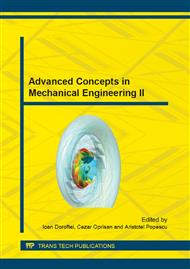p.343
p.349
p.353
p.359
p.365
p.371
p.377
p.383
p.389
Considerations about the Role and Efficiency of the Transceiver's Heat Sink during Critical Situations
Abstract:
Thermal analysis of electronic equipment is becoming one of the primary aspects of many researches considering the trend line of reducing the size and increasing the speed. As the power of these systems increases and the space allotted to them decreases, heat flux or density becomes a critical factor in designing electronic equipment. The paper deals with thermal behavior of a particular heat sink designed for a VHF-UHF dual-band transceiver with a maximal power of 50 W. In this case, the electrical part generating this amount of power, is a MOSFET having a junction maximal temperature of 150 °C. A 3D CAD model was developed in proEngineer and finite element analyses were run in ANSYS in order to establish the best functioning conditions of the transceiver.
Info:
Periodical:
Pages:
365-370
Citation:
Online since:
October 2014
Authors:
Keywords:
Price:
Сopyright:
© 2014 Trans Tech Publications Ltd. All Rights Reserved
Share:
Citation:


